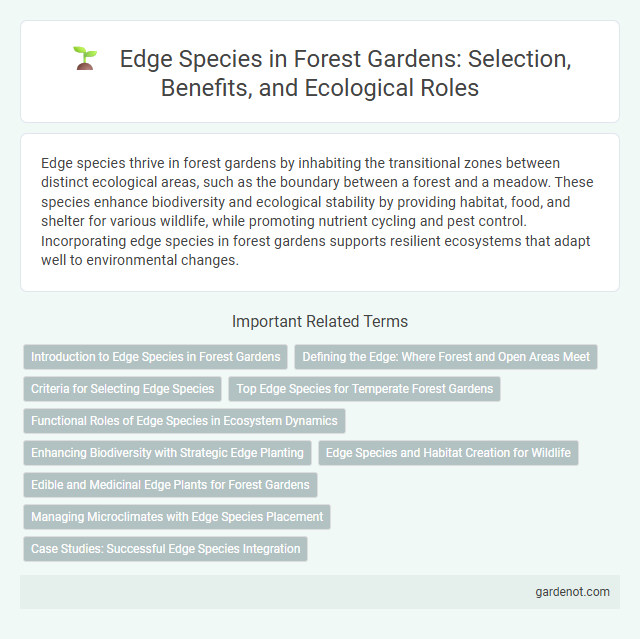Edge species thrive in forest gardens by inhabiting the transitional zones between distinct ecological areas, such as the boundary between a forest and a meadow. These species enhance biodiversity and ecological stability by providing habitat, food, and shelter for various wildlife, while promoting nutrient cycling and pest control. Incorporating edge species in forest gardens supports resilient ecosystems that adapt well to environmental changes.
Introduction to Edge Species in Forest Gardens
Edge species in forest gardens thrive at the intersection of different habitats, such as the boundary between dense trees and open spaces. These plants and animals benefit from increased sunlight, diverse soil conditions, and greater resource availability, making them vital for ecological balance and biodiversity. Incorporating edge species enhances resilience, supports pollinators, and promotes nutrient cycling within the forest garden ecosystem.
Defining the Edge: Where Forest and Open Areas Meet
Edge species thrive in the transitional zone where forest and open areas converge, creating unique habitats rich in biodiversity. These species capitalize on the increased sunlight and diverse plant life found at forest edges, which support a variety of insects, birds, and mammals. Managing edges in a forest garden maximizes ecological benefits by encouraging species that promote pollination, pest control, and soil health.
Criteria for Selecting Edge Species
Edge species in forest gardens thrive by maximizing sunlight exposure, enhancing biodiversity, and supporting ecosystem services such as pollination and pest control. Key criteria for selecting edge species include adaptability to variable microclimates, compatibility with adjacent plant communities, and the ability to create beneficial habitat structures. Prioritizing native species with diverse growth forms and seasonal interest fosters resilient and productive forest garden margins.
Top Edge Species for Temperate Forest Gardens
Top edge species for temperate forest gardens include serviceberry (Amelanchier alnifolia), elderberry (Sambucus canadensis), and hazelnut (Corylus americana), which thrive in the transitional zones between open and wooded areas. These species provide valuable ecosystem services such as wildlife habitat, pollinator support, and erosion control while producing edible fruits and nuts. Their adaptability to varying light conditions and soil types makes them essential for enhancing biodiversity and productivity in forest garden edges.
Functional Roles of Edge Species in Ecosystem Dynamics
Edge species in forest gardens play crucial functional roles by enhancing biodiversity and promoting ecosystem stability. These species often act as important pollinators, seed dispersers, and natural pest controllers, facilitating nutrient cycling and habitat diversification. By thriving at habitat boundaries, edge species support ecological connectivity and resilience against environmental disturbances.
Enhancing Biodiversity with Strategic Edge Planting
Strategic edge planting in forest gardens significantly enhances biodiversity by creating diverse habitats that support a wide range of flora and fauna. Edge species such as hawthorn, elderberry, and hazel provide food, shelter, and nesting sites for pollinators, birds, and beneficial insects. Incorporating layered vegetation along garden margins promotes ecological resilience and increases the overall productivity of the forest garden ecosystem.
Edge Species and Habitat Creation for Wildlife
Edge species thrive in transitional zones where forest meets open land, creating diverse habitats that support a wide range of wildlife. These species enhance biodiversity by providing shelter, food, and breeding grounds for birds, mammals, and insects, contributing to the ecological balance within a forest garden. Designing forest gardens with varied edge environments fosters habitat creation, promoting resilience and sustainable wildlife populations.
Edible and Medicinal Edge Plants for Forest Gardens
Edge species in forest gardens, such as comfrey, nettle, and elderberry, thrive at the interface between woodland and open space, providing abundant edible and medicinal benefits. These plants enrich soil health, attract beneficial pollinators, and offer nutrients through leaves, berries, and roots valued in traditional remedies. Integrating edible and medicinal edge plants enhances forest garden diversity, resilience, and yields of natural health-supporting foods.
Managing Microclimates with Edge Species Placement
Edge species play a crucial role in managing microclimates within a forest garden by creating transitional zones that moderate temperature fluctuations and wind exposure. Strategic placement of these species enhances biodiversity and supports the growth of shade-tolerant and sun-loving plants by providing varied light and moisture conditions. Utilizing edge species effectively contributes to improved resilience and productivity of the forest garden ecosystem.
Case Studies: Successful Edge Species Integration
Edge species play a crucial role in forest garden ecosystems by enhancing biodiversity and improving resilience. Case studies from temperate zones reveal that integrating species such as hazel (Corylus avellana) and hawthorn (Crataegus monogyna) along forest edges increases habitat complexity and supports pollinators effectively. Successful edge species integration also promotes soil health and microclimate regulation, contributing to overall forest garden productivity.
Edge species Infographic

 gardenot.com
gardenot.com